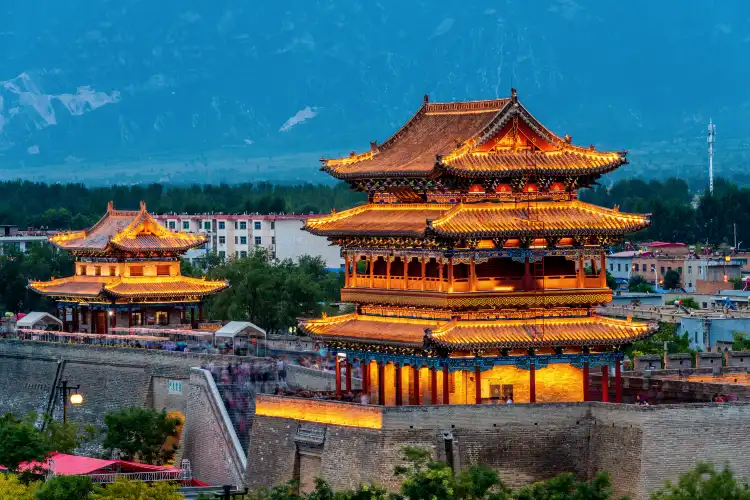
Search Your Xinzhou Hotels
Enter your dates for the latest hotel rates and availability.
Swipe up to view more
Filter by:
Hotel Star Rating
≤2345
Popular Filters
Amazing 4.5+Great 4.0+Good 3.5+Pleasant 3.0+2134 hotels to stay in Xinzhou
Choose your travel dates to see the latest prices and deals.
Most Booked
Lowest Price
Closest to Downtown
Highest Rated



Hotel near Xinfu District,Xinzhou
AAibo 2023.05.03
The hotel environment is good, but in the suburbs, the sanitation is average, the facilities are old, and it was previously considered a high-end hotel. It is recommended to renovate.
Excellent
20 reviews
4.3/5
Price from
PHP 1,788
per night



Hotel near Xinfu District,Xinzhou
GGuest User 2024.10.10
The room is large, very clean, smart curtains, and the surrounding environment is very good. There is free parking. The waiters are enthusiastic and answer all your questions. I will stay here next time I pass by.
Excellent
108 reviews
4.5/5
Price from
PHP 1,515
per night
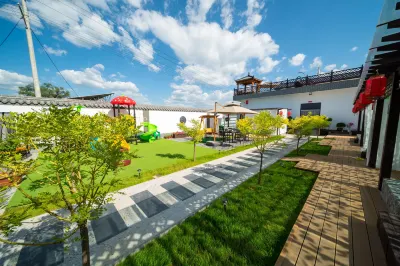


Hotel near Xinfu District,Xinzhou
GGuest User 2023.06.22
The rooms in the homestay are very new, the environment facilities and other aspects are very good, the boss is very real, basically responsive. In Qicun, the preferred place to take a bath, there are chess and card rooms and tea rooms, suitable for all kinds of family and business gatherings, the main price is not expensive, will come again next time you go to Qicun
15 reviews
3.9/5
Price from
PHP 1,170
per night

You Might Like
Hotels With BreakfastHotels With Twin RoomHotels With 1 Double BedHotels With Swimming PoolHotels With Free Cancellation



Hotel near Xinzhou Ancient City,Xinzhou 100% of visitors choose this area
Lliugang1964 2024.08.11
The hotel is located in the ancient city, very close to the most popular Taishan Temple Tea House and Taishan Temple Lane, less than five minutes' walk. There are many B&Bs and hotels nearby, and it can be regarded as a quiet place in the ancient city. The environment is very good, the scenery is very thoughtful, and there are pools, slides and observation decks for children to play in the courtyard. The room is spacious and the hot spring pool is also large and can be filled with water in about five minutes. Mineral water and American style are all available at will. Before check-in, the staff will adjust the air conditioner to 26℃ in advance, and the front desk is also very considerate and enthusiastic.
Outstanding
254 reviews
4.8/5
Price from
PHP 4,513
per night
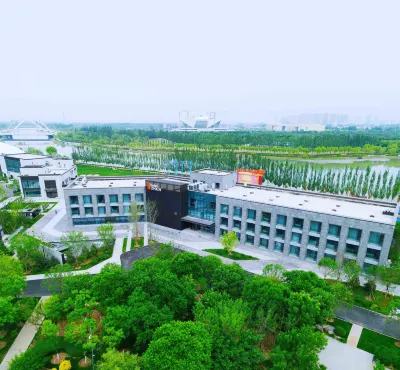
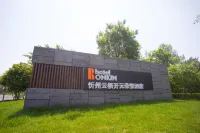

Hotel near Xinfu District,Xinzhou
GGuest User 2024.08.20
酒店的外觀設計簡約大氣,內部裝修精美,前台小徐和小李服務非常周到,態度熱情,非常值得讚揚,客房設施非常貼心,提供了很多便利小物品,房間寬敞明亮乾淨整潔,有大的落地窗,窗外風景優美。是一個值得推薦的酒店。
Outstanding
610 reviews
4.8/5
Price from
PHP 2,437
per night

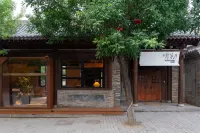
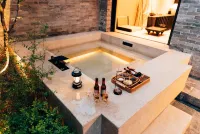
Hotel near Xinzhou Ancient City,Xinzhou 100% of visitors choose this area
ZZhumamaaixiaoheizhu 2024.10.01
The location of the inn is good. Just on the side of the road. Walk 2 minutes to the bar street parking lot. Turn right out of the inn and walk for a few minutes to Taishan Temple Street.
The room is large, the design is characteristic and stylish. Clean, Herborist toiletries. Disposable toilet cover. There is also a lady's personal bag. Very thoughtful. Very satisfied inn.
Zhangzhou is very good, with a special ancient city flavor.
Along the way, I went to Datong Ancient City, Zhangzhou Ancient City, Pingyao Ancient City. And my girlfriends have always been the best in Zhangzhou Ancient City.
Outstanding
237 reviews
4.8/5
Price from
PHP 4,553
per night



Hotel near Xinfu District,Xinzhou
BBuqibieli 2024.08.24
Location: Located in the city center, convenient transportation and procurement.
Indoor facilities: the equipment is intelligent and complete, and equipped with green plants, beautiful and comfortable, the bathroom is separated from wet and dry, and the room has good sound insulation.
Living experience: There are a variety of free services such as bathing and bathing. The breakfast dishes are rich and delicious; the staff are warm and patient, and the service attitude is very good. Overall, strong Amway! ! !
Outstanding
122 reviews
4.6/5
Price from
PHP 1,860
per night



Hotel near Xinzhou Ancient City,Xinzhou 100% of visitors choose this area
AAnonymous User 2024.08.21
In this busy world, I found a peaceful haven. Every room is like a corner forgotten by time, full of stories and temperatures. In the evening, make a cup of hot tea and let your thoughts float under the stars outside the window. B&B is not only accommodation, but also a lifestyle. 🏡✨ Are you ready to embrace this simplicity and tranquility? 🚀
Outstanding
145 reviews
4.8/5
Price from
PHP 2,076
per night



Hotel near Xinfu District,Xinzhou
AAnonymous User 2024.10.23
Wow, I looked at the travel photography 😊 booked, it exceeded expectations, the evaluation said that the sound insulation is not good, and I am a little worried, but after the actual stay, there is no at all, the living is very good, the children also like ❤️ The main environment and service have nothing to say-̗̀ (๑ᵔ⌔ᵔ๑) My child's favorite is the infinity pool ✌️ Absolute ✅ Movies, recommended to stay, very close to the ancient city of Zhangzhou, tired directly bath, massage, gentle ♨️, how cool 😁
Outstanding
146 reviews
4.7/5
Price from
PHP 1,731
per night

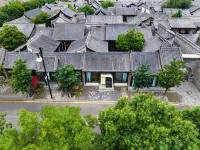

Hotel near Xinzhou Ancient City,Xinzhou 100% of visitors choose this area
GGuest User 2024.11.22
The room has floor-to-ceiling windows and the bathroom is large, spacious and bright. The facilities are also very good. The service is also in place. The price is very high, toothpaste toothbrushes are wooden/bamboo, toiletries are European Sudan, hair dryer is Dyson, and even the tea provided is a small can of tea (or authentic small can of tea, not a fake). Fruits and snacks were also sent, and breakfast was KFC. Generally, this kind of hotel will be equipped with at least 800 hotels. I think the store cost is very high, far more than the general hotel spare parts, it can be seen that it is very sincere in operating. I will choose here next time I come to Zhangzhou. I hope the store business will be prosperous for a long time. 🌹🌹🌹
Outstanding
147 reviews
4.8/5
Price from
PHP 4,096
per night
Most-booked Xinzhou hotels
See all
Check out these top-booked hotels from the past 30 days!
No.1
4.8/5
1073 reviewJi Hotel (Wutai Mountain Scenic Area Branch)
Hotel near North Line/Guangming Temple, Wutai
"Friendly front desk staff""Delicious breakfast"
Select dates to view pricesNo.2
4.4/5
432 reviewFanhua Hotel
Hotel near Xinfu District, Xinzhou
"Large rooms""Classy environment"
Select dates to view pricesNo.3
4.5/5
2154 reviewWutai Mountain Marriott Hotel
Hotel near Wutaishan Scenic Area South Gate, Wutai 1.2% of visitors choose this area
"Classy environment""Delicious breakfast"
Select dates to view pricesNo.4
4.8/5
497 reviewChuzhou Ancient City Cidi Huahua Homestay
Hotel near Xinzhou Ancient City, Xinzhou 100% of visitors choose this area
"Classy environment""Great amenities"
Select dates to view pricesNo.5
4.6/5
522 reviewYunmu Hot Spring Resort
Hotel near Xinfu District, Xinzhou
"Classy environment""Friendly front desk staff"
Select dates to view pricesNo.6
4.8/5
116 reviewWutaishan Huixinyuan Homestay (Zhenrongsi Branch)
Hotel near Wuye Temple, Wutai 94.8% of visitors choose this area
"Clean and tidy""Great service"
Select dates to view pricesNo.7
3.6/5
19 reviewWutaishan Jiuhong Hotel
Hotel near Wuye Temple, Wutai 94.8% of visitors choose this area
"Great service""Great stay!"
Select dates to view pricesNo.8
4.5/5
1176 reviewYunlong Hotel
Hotel near Wuye Temple, Wutai 94.8% of visitors choose this area
"Delicious breakfast""Friendly front desk staff"
Select dates to view pricesNo.9
4.4/5
44 review五台山朋來賓館
Hotel near Wuye Temple, Wutai 94.8% of visitors choose this area
"Great service""Clean and tidy"
Select dates to view pricesNo.10
4.8/5
100 reviewJI Hotel (Xinzhou Dingxiang Bus Station)
Hotel near Dingxiang
"Great service""Great amenities"
Select dates to view pricesBest Xinzhou hotels with breakfast
See all
Start your day with a tasty breakfast at one of our top hotels in Xinzhou.
Qixiange Guest Hotel
Hotel near Wuye Temple, Wutai 94.8% of visitors choose this area
The Qixiange Guest Hotel provides a great place for travelers to relax after a busy day. Visitors to Wutai will find that the Qixiange Guest Hotel is a fantastic accommodation choice. Wutaishan Railway Station is the closest major transportation option, approximately 51km away. Wutaishan Railway Station is the closest option for those who prefer to travel by train, approximately 51km away. This hotel is located near many of Wutai's attractions including Nanshan Temple, Guanyin Cave and Banruo Spring. When guests have some time on their hands they can make use of the onsite facilities. This Wutai hotel provides parking on site. Guests tell us the location of this hotel is fantastic. This hotel is particularly popular with those traveling with families.
4.6/5
Outstanding378 reviewPrice per night from: PHP 8922
Thanks Hotel Mount Wutai
Hotel near South Line/Baiyun Temple, Wutai
🌹 This time I stayed at Wutaishan Nanman Nanman Hotel. First of all, the hotel location is very good. There is a separate parking lot and charging pile. The rooms are mountain view rooms. The natural beauty is within reach. The experience is superb. It is convenient to travel. Go to the hotel. The lobby is quiet and elegant. The service staff is warm and thoughtful. All kinds of intimate details and services are very good 👍, the beauty of art is in the table case, the culture is in the wall room, from check-in to check-out, I feel at home, the room is rich, clean and tidy, the bedding is soft and comfortable, and I feel until dawn. The bathroom facilities are complete, hot water is sufficient and the water pressure is stable. The hotel's breakfast is rich in variety and tastes good. Whether it is business travel or leisure self-driving travel, this is the ideal choice 👏
4.8/5
Outstanding25 reviewPrice per night from: PHP 11142
Friendship Hotel
Hotel near Wuye Temple, Wutai 94.8% of visitors choose this area
Located at the core acre of Wutaishan Mountain scenic acrea, the Friendship Hotel (Wutaishan Youyi Jiudian) is situated close to Wutaishan National Forest Park.This Wutaishan hotel provides a variety of guestrooms and suites, all equipped with modern amenities including in-room safes, mini bars and mini fridges.Diners can take their pick at the on-site Chinese and Western restaurant. Those not ready for staple food may head over to the lobby bar and Cafe while chatting with friends over a cup of coffee and drinks.For those after recreational pursuits, there are karaoke rooms and dancing hall. Guests can also stay active in the gym, or just play a game of billiards and chess and cards.
4.0/5
Very Good1079 reviewPrice per night from: PHP 1924
Wutai Mountain Yinlong Mountain Villa
Hotel near Wuye Temple, Wutai 94.8% of visitors choose this area
The Wutai Mountain Yinlong Mountain Villa provides a great place for travelers to relax after a busy day. The Wutai Mountain Yinlong Mountain Villa offers a pleasant stay in Wutai for those traveling for business or leisure. The hotel is located approximately 49km from Wutaishan Railway Station. The nearest railway station is Wutaishan Railway Station, approximately 49km away. With multiple attractions nearby including Da Wenshusi, Fanjing Mountain and Wanfoge Temple, guests will find plenty to keep themselves occupied. This hotel makes a great place to kick back and relax after a long day of sightseeing. Guests of this Wutai hotel can make use of the parking facilities. This hotel is particularly popular with those traveling with families.
4.2/5
Very Good2196 reviewPrice per night from: PHP 2076
Wutaishan Yahe Yunshe (Wuye Temple Branch)
Hotel near Wuye Temple, Wutai 94.8% of visitors choose this area
The Wutaishan Yahe Yunshe (Wuye Temple Branch) was recently opened in 2021, making it a fantastic choice for those staying in Wutai. In terms of transportation, Wutaishan Railway Station is approximately 47km away. The nearest railway station is Wutaishan Railway Station, approximately 47km from the hotel. With multiple attractions nearby including Bishan Temple, Fanxianshan and Jifu Temple, guests will find plenty to keep themselves occupied. At the end of a busy day, travelers can unwind and relax in the hotel or go out and enjoy the city. For those driving themselves, parking is provided on site. When it comes to Wutai hotels, the Wutaishan Yahe Yunshe (Wuye Temple Branch) is highly regarded for its excellent facilities. This hotel is a popular accommodation for groups of friends traveling together.
4.7/5
Outstanding709 reviewPrice per night from: PHP 5299
Wutai Mountain Yizhanmingdeng· Chanxin Shuyuan
Hotel near West Line/Longquan Temple, Wutai
The Wutai Mountain Yizhanmingdeng· Chanxin Shuyuan is a great choice for guests looking for accommodation in Wutai, having been recently opened in 2022. The hotel is approximately 54km away from Wutaishan Railway Station. Wutaishan Railway Station is the closest option for those who prefer to travel by train, approximately 54km away. There is no shortage of things to see in the area, with the Longquan Temple, Linggong Tower and Guanghua Temple all nearby. At the end of a busy day, travelers can unwind and relax in the hotel or go out and enjoy the city. Guests of this Wutai hotel can make use of the parking facilities. According to our trusted guests, the facilities at this hotel are first-rate. This hotel is particularly popular with those traveling with friends.
4.7/5
Outstanding175 reviewPrice per night from: PHP 3591
Wutai Mountain Qingfeng Mingshi Hotel (Guanghuasi Branch)
Hotel near Wutai
When our family of three went to Mount Wutai for a trip, we chose to stay at Qingfeng Hotel. Before arriving at the hotel, the boss helped us contact the vehicle from Taiyuan to Mount Wutai, and picked us up at the parking lot after arriving at Mount Wutai. The boss's enthusiasm was felt throughout the whole process. After checking in, although the hotel is not big, it is very warm everywhere. There are smart toilets, smart Xiaoai, and the beds are also very clean, which makes it very comfortable to live. Later, the child caught a cold in Mount Wutai, and the boss's wife provided us with a lot of help. This trip to Mount Wutai was very smooth, and I will choose here next time I go to Mount Wutai
4.7/5
Outstanding570 reviewPrice per night from: PHP 1667
Weiman Hotel
Hotel near West Line/Longquan Temple, Wutai
The Weiman Hotel provides a great place for travelers to relax after a busy day. The Weiman Hotel offers a pleasant stay in Wutai for those traveling for business or leisure. The hotel is located approximately 54km from Wutaishan Railway Station. Wutaishan Railway Station is the closest option for those who prefer to travel by train, approximately 54km away. There is no shortage of things to see in the area, with the Longquan Temple, Xiantong Temple and Guanyin Cave all nearby. In their spare time, guests can explore the hotel's surroundings. This Wutai hotel offers parking on site. Our guests consider this hotel to have excellent service. For guests traveling with groups of friends, this hotel is consistently one of the most popular choices.
4.8/5
Outstanding326 reviewPrice per night from: PHP 1643
You Jian Wu Xiang Twenty six Villages , Mount Wutai
Hotel near West Line/Longquan Temple, Wutai
Facilities: Newly renovated, unique style! The bed was very comfortable, the items were very satisfactory, and the pillows were hard and soft. Can meet different needs.
Hygiene: My wife is very picky and can meet her standards not much. She can't find anything dissatisfied!
Environment: In the scenic area, there is still a certain distance from the central scenic area, not noisy. very quiet! Driving to the main scenic area, not far away, 4-5 minutes. Very suitable for meditation. As soon as I entered the room, a faint scent of musk scent was very refreshing!
Service: The service is simply amazing! The boss is very enthusiastic! Enthusiasm to the point that I doubt if I am not in the famous scenic spot ③. Before it arrives, the boss will take the initiative to contact you and ask if you have made an appointment for the relevant scenic spot. We came for the first time and didn't do too many strategies. The boss patiently explained very carefully, and told how to operate step by step. Since it arrived at night, the boss also enthusiastically prepared a late night snack! Moving + breakfast is normal at 7:30, we are nervous, want to worship Buddha earlier. The boss went to the kitchen to explain, we had breakfast at 7 o'clock. I was very touched. moved++
After entering the mountain, let the boss introduce a narrator and the fee is not high, telling us a lot of etiquette and precautions. Let us do more work! Avoid a lot of pits! It also saves a lot of time. In fact, the boss also informed some, too much bad memory. Fortunately, the narrator added it again.
I couldn't get incense after 12 o'clock. I bought some mountain goods on the road and returned to the hotel after two o'clock.
Feel the afternoon tea, each room asks 100+ free afternoon tea, you can add, you need to pay the extra fee! Great! It seems that the room rate is higher, and I don't think it is too high, but I think it is very reasonable! The most important thing is that the boss is caring all the time. Let our family 7-8 feel very kind! It feels like a long-time friend, responsive! It's really comfortable. My wife asked me if the people here are affected by Buddha all year round, so kind! I don't think it makes sense!
4.9/5
Perfect120 reviewPrice per night from: PHP 4657
Mehood Hotel (Xinzhou City)
Hotel near Xinfu District, Xinzhou
The Mehood Hotel (Xinzhou City) provides a great place for travelers to relax after a busy day. Visitors to Xinzhou will find that the Mehood Hotel (Xinzhou City) is a fantastic accommodation choice. Traveling to the hotel is easy with Xinzhou Railway Station located approximately 5km away and Wutaishan Airport roughly 41km away. This hotel is located near many of Xinzhou's attractions including Xinzhou Jiuyuan Gutaoci Museum, Feihong Playground and Huayan Temple. After a long day of sightseeing, guests can retire to the comfort of the hotel. This Xinzhou hotel features parking on site. Our guests consider this hotel to have excellent service. For guests traveling with families, this hotel is consistently one of the most popular choices.
4.8/5
Outstanding2010 reviewPrice per night from: PHP 1940
Find best four-star Xinzhou hotels
See all
For business or leisure, these four-star hotels in Xinzhou provide the perfect stay for your journey.
Mount Wutai Manjia Hotel
Hotel near Expressway/Shijuzhen, Wutai 4% of visitors choose this area
The hotel is located in Jingangku Village, Jingangku Township, Wutai Mountain Scenic Area, next to Jinyuan Gas Station. It is close to the ancient temple Dabao Temple and the "See Wutai Mountain Again" scenic spot. It is surrounded by mountains on all sides, has a broad view, warm and comfortable rooms, three-story stairs and supporting facilities The facilities and services are very complete, making it an ideal place for tourists to stay.The hotel has supporting guest rooms and suites, various restaurants, 21 private rooms, a large parking lot, a multi-functional banquet hall, a multimedia conference room, and a specialty supermarket. It integrates catering, accommodation, business, tourism, and leisure, and always adheres to the principle of "guest first, service first" "The purpose is to provide every guest with high-quality services and a comfortable stay and dining experience!
4.6/5
Outstanding335 reviewPrice per night from: PHP 1868
Huameishi Hot Spring Hotel (Xinzhou Ancient City Store
Hotel near Xinzhou Ancient City, Xinzhou 100% of visitors choose this area
The hotel is located at No. C-5, intersection of Bar Street and Shilang Alley in Xinzhou Ancient City, Xinfu District. It is about 570 meters on foot from Xinzhou Ancient City. It is adjacent to Xiurong Academy, West Garden and Taishan Temple Snack Street in Xinzhou Ancient City. The surrounding transportation is convenient, making it very convenient for traveling and playing.
Room facilities: The room is equipped with zero-pressure mattresses of well-known brands and high-grade latex zero-pressure pillows. The bedding is delicate high-woven plain cotton linen, and there is also a custom-made duck down quilt core, which can provide guests with a comfortable sleeping experience. Moreover, the whole house is equipped with an intelligent voice control system. Just a gentle call, and the intelligent service will respond immediately. There is also a lovely delivery robot, which brings convenience to guests and adds technological fun. Some rooms are equipped with independent hot spring soaking pools, allowing guests to enjoy the nourishment of hot springs in a private space.
Other facilities: The hotel has a multi-functional conference hall, which can meet the needs of various business meetings. At the same time, the laundry room is fully equipped with washing machines, drying and ironing equipment, providing convenience for guests' journeys and bringing the warmth of home. The cinema room is equipped with high-end audio-visual equipment such as 4K projectors.
4.7/5
Outstanding268 reviewPrice per night from: PHP 3423
Yunxuan · Xi Hot Spring Homestay (Zhangzhou Ancient City Branch)
Hotel near Xinzhou Ancient City, Xinzhou 100% of visitors choose this area
The comments I read before came, compared a few, and finally chose Yunxuan. After arriving, the homestay is in the ancient city, and a 3-minute walk next to it is a large free parking lot. Entering the hotel, the decoration is warm and comfortable, the weather is good, the main thing is that the boss sister is good, the front desk is finished and took to the room, and briefly introduced it. The room is clean and hygienic, with floor heating, smart toilet, everything is fine, there is a chance to come again. Highly recommend to everyone
4.9/5
Perfect198 reviewPrice per night from: PHP 4529
Huazhushe · Yunju B & B in Mingzhai, Wutai Mountain
Hotel near Wuye Temple, Wutai 94.8% of visitors choose this area
The Huazhushe · Yunju B & B in Mingzhai, Wutai Mountain is an ideal spot for travelers wanting to discover the city. The Huazhushe · Yunju B & B in Mingzhai, Wutai Mountain offers a pleasant stay in Wutai for those traveling for business or leisure. The hotel is approximately 51km away from Wutaishan Railway Station. Traveling to and from the railway station is easy with Wutaishan Railway Station located approximately 51km away. Seeing Wutai's sights from this hotel is easy with Wanfoge Temple, Pusa Ding (Bodhisattva Top) and Pagoda Temple all close by. In their spare time, guests can explore the hotel's surroundings. Guests of this Wutai hotel can make use of the parking facilities. Germaphobes can rest easy - the level of cleanliness is highly rated at this hotel. This hotel is a popular accommodation for guests traveling with families.
4.6/5
Outstanding519 reviewPrice per night from: PHP 3094
THE WUTAI MOUNTAIN Pu yin shan she
Hotel near South Line/Baiyun Temple, Wutai
Environment: I saw it online first, and was even more surprised when I arrived at the hotel. It is a well-decorated inn with high-end decoration. The location is easy to find. There is a tea room and a studio. You can sit down and meditate when you have nothing to do. There is also a parking space. It is very convenient. It has everything. The service is also very enthusiastic. They took the initiative to tell us the precautions for entering Mount Wutai. The room is very clean and spacious. The store also has breakfast, which is also very exquisite and delicious. I will recommend more friends to come here.
4.7/5
Outstanding336 reviewPrice per night from: PHP 1804
Yuanping Yellow River Kyoto Hotel
Hotel near Yuanping
Yuanping Yellow River Kyoto Hotel is located in the center of Yuanping City, on Qianjin West Street, adjacent to the Hutuo River, and echoing the People's Square. The hotel is surrounded by natural scenic spots and cultural relics such as Tianya Mountain Scenic Area, Wufeng Mountain, Daying Hot Spring, etc; It is 2.5 kilometers away from the railway station, 3 kilometers away from the long-distance bus station, and 3.5 kilometers away from the highway, with smooth transportation.Yuanping Yellow River Kyoto Hotel is subordinate to Yuanping Jinquan Construction and Installation Co., Ltd. The hotel covers an area of 28000 square meters, with a construction area of 36000 square meters, and over 300 guest parking spaces. It is a designated reception unit designated by the Yuanping Municipal Party Committee and Municipal Government.Founded in 2007, Yuanping Huanghe Kyoto Hotel is a comprehensive hotel integrating accommodation, catering, business, and leisure. It was upgraded and renovated as a whole in 2023. Currently, it has presidential suites, executive suites, administrative and business standard rooms, administrative and business large bed rooms, comfortable single rooms, and elegant and quiet guest rooms. All are equipped with intelligent butler services, and supporting facilities are upgraded with brand new equipment. There are 4 large, medium, and small conference rooms, which can accommodate different meetings for 20-200 people. The hotel has a cafeteria, VIP banquet hall, and 11 luxury private rooms, which can accommodate 200 people at the same time. It mainly serves Cantonese, Sichuan, Hunan, Shanxi, and local specialties. In addition, the hotel also has chess and card rooms, business centers, commodity bars, leisure tea houses, and other facilities and services, making it an ideal place for business negotiations, tourism, leisure, and meetings.
4.6/5
Outstanding415 reviewPrice per night from: PHP 1098
Wutaishan Yiming Lantern Zen Xinju Hotel
Hotel near West Line/Longquan Temple, Wutai
The Wutaishan Yiming Lantern Zen Xinju Hotel provides a great place for travelers to relax after a busy day. The Wutaishan Yiming Lantern Zen Xinju Hotel is an ideal choice for travelers who want to take in the sights and sounds of Wutai. In terms of transportation, Wutaishan Railway Station is approximately 52km away. Traveling to and from the railway station is easy with Wutaishan Railway Station located approximately 52km away. With multiple attractions nearby including Puhua Temple, Wanfodong Zhenrong Temple and Zhenhaisi, guests will find plenty to keep themselves occupied. In their spare time, guests can explore the hotel's surroundings. This Wutai hotel offers parking on site. Guests tell us the location of this hotel is fantastic.
4.4/5
Excellent77 reviewPrice per night from: PHP 3295
Floral·Wutai Mountain Yi'an Boutique Hotel(Wuye Temple)
Hotel near West Line/Longquan Temple, Wutai
The Floral·Wutai Mountain Yi'an Boutique Hotel(Wuye Temple) is an ideal spot for travelers wanting to discover the city. The Floral·Wutai Mountain Yi'an Boutique Hotel(Wuye Temple) is an ideal choice for travelers who want to take in the sights and sounds of Wutai. In terms of transportation, Wutaishan Railway Station is approximately 53km away. Wutaishan Railway Station is approximately 53km away by road. The nearby area boasts an abundance of attractions including Longquan Temple, Nanshan Temple and Zhenhaisi. This hotel makes a great place to kick back and relax after a long day of sightseeing. This Wutai hotel features parking on site. According to our trusted guests, the facilities at this hotel are first-rate. For guests traveling with groups of friends, this hotel is consistently one of the most popular choices.
4.8/5
Outstanding150 reviewPrice per night from: PHP 4337
Jingshe Guanshan Homestay
Hotel near South Line/Baiyun Temple, Wutai
There is basically no chain five-star brand hotel in Wutai Mountain Scenic Area. I found a newly opened homestay on the Internet to experience it. It was still a pleasant surprise. I actually used the electric kettle of Jigu. The bathroom is also good. The overall design is very good. There is a good rooftop, and the sunny weather is estimated to see the stars. The location is slightly remote, but self-driving does not affect. No elevator is a flaw, but the guy in the store is still very active in helping with luggage, which is commendable. The card is out of power. There is no uninterrupted power supply. The electronic equipment is not charged in the afternoon. The drugs placed in the refrigerator are not dared to use. It is recommended that the merchants use the power card to plug it in 24 hours. There is a flaw, breakfast is not a general shabby, 2 pickles, an egg, a bowl of millet porridge, a flower roll. It is really far from worthy of this price, and the breakfast at home is much better. In addition, the overall satisfaction is very satisfactory, if the price is acceptable, it is recommended to stay.
4.8/5
Outstanding93 reviewPrice per night from: PHP 5491
No Two Inn (Wutaishan Scenic Spot)
Hotel near West Line/Longquan Temple, Wutai
First of all, the inn was responsible for picking us up. It was already very late at night when we arrived at the entrance of the scenic spot, and the inn quickly picked us up. Then, the courtyard of the inn is beautiful, with classic Chinese style. The room is much better than the hotel's own photos. It is clean, comfortable and bright, with plenty of hot water. Disposable toilet covers and slippers are provided, which are of good quality. I took photos of the outside of the inn, but forgot to take photos of the room. Breakfast is provided, a home-cooked meal, but it is very comfortable to eat, especially for friends who go out of town. If you are not used to eating habits, this kind of breakfast can definitely warm your stomach for the day. The front desk service is also very good.
4.6/5
Outstanding163 reviewPrice per night from: PHP 1868
Read reviews of guests who stayed at Xinzhou hotels
See all
Browse these genuine traveler ratings & reviews to find your perfect stay.
4.9/5
Perfect
SSuibozhuliu~suiyueranLet me talk about the conclusion first. Huayuan should be the most cost-effective hotel in Wutai Mountain (the hotel has not lived in the hotel, I don’t know that the upper and lower limits are too different, and there is no unified management standard). The clean facilities here are more expensive than Huayuan. It is cheaper than it. It is clean and comfortable, including the size of the room!
I am here to thank the white sister at the front desk for helping to upgrade the room. The service attitude is very good, like it!
4.8/5
Outstanding
ZZuzuFacilities: There is a dirt road outside the B&B, it is dirty, and there is no parking space. We just park everywhere. It was around 9pm when the owner let us park next to a huge smelly garbage dump. There is a construction site outside the hotel, which feels really bad. The public areas in the B&B are more elegant, but the room facilities are outdated. There are no hangers or places to dry the clothes, and the experience of putting them on the railings of the walkway is very poor.
Hygiene: Overall it is relatively clean, but there are small bugs on the floor and walls at night. (The first picture was taken when I came back today to collect clothes. There was no hanging paper when we checked in)
Service: After parking the car at night, the male shop owner took the initiative to help carry the box and did not let the box walk all the way in the mud. The female shop owner also asked us enthusiastically how we came, how to get there, and how to get to the scenic spot. She also took the initiative to ask us not to drive the next day because there were many people and cars, so she asked the male shop owner to take us to the starting point and take the bus, which was great with our children. Sit alone. It turned out that the next morning there was nothing about last night. I took the initiative to ask her how to send us off. She immediately pretended to be stupid and said you can take the bus yourself! I was very puzzled. After I went out, I met the male shopkeeper. As soon as he saw us, he immediately said, ”Beauty, you can go.” (Obviously he didn't forget the conversation last night) But the woman chased her out and said, yes, they will go and take the bus by themselves. The man understood it as soon as he heard it, and I identified the fake enthusiastic female shop owner. In the end, I asked the male shopkeeper to take us out of the sun-drenched and dirty dirt road and take us to the entrance of the village to take a bus. I took my children for more than 10 stops along the way to the Wu Dad Temple.
There are many B&Bs and hotels on Wutai Mountain. This B&B is not worth more than 500 in terms of location and setting. Having a lot of frivolous public facilities in the store does not make any sense to our guests. The experience of staying here is not good!
One Sleep One She B&B
Hotel near Wutaishan Scenic Area South Gate, Wutai 1.2% of visitors choose this area
Price per night from: PHP 1307
4.8/5
Outstanding
GGuest UserThe room is very clean and the service is very good. I have lived many times. The price is not expensive. The main reason is that the boss is good. The safety factor is high. Dongtian is warm and cool in summer. I will go to his house next time.
Xixiangfeng Hotel (See Wutaishan Branch)
Hotel near Wutaishan Scenic Area South Gate, Wutai 1.2% of visitors choose this area
Price per night from: PHP 962
4.7/5
Outstanding
ZZhixinbaobaoThe room was very clean. The owner was very nice. After booking, he reminded us to bring down jackets. Although we forgot it in the end, we had to go back and spend most of the day. It was already late when we got to the mountain. The owner was very considerate and waited for us and provided us with tour guidance. There are many vegetarian restaurants within walking distance of the B&B. There is a parking lot at the door. It is also very close to the bus stop of the scenic area. It takes two stops to reach Shuxiang Temple. It is recommended.
Floral Hotel·Meeting without forgetting the original heart (Wutaishan Wuye Temple Branch)
Hotel near Wuye Temple, Wutai 94.8% of visitors choose this area
Price per night from: PHP 2573
4.7/5
Outstanding
VVegan in ChinaVery friendly, kind staff. Room is clean and well decoratedn, location is great. My only criticism is I don't like that there is a big bottle of water which appears generous until you realize you have to pay for it, as well as a phone charger which you also need to pay to use. It's not that I mind paying, but by putting it in the room, it seems like an extra cash grab which takes away from the initial warm hospitality, especially since the room isn't cheap.
Wutai Mountain Tingfengyin Inn (Wuye Temple Branch)
Hotel near Wuye Temple, Wutai 94.8% of visitors choose this area
Price per night from: PHP 2341
4.7/5
Outstanding
YYunshanyiIt feels very comfortable entering the hotel lobby! It has the foundation of tea culture! The room was clean, the bed was good to sleep on, and there was a tea set for making tea. I happened to bring tea with me. The service at the front desk was also very good. If I needed ice cubes, they would try to find some for me! Although it’s not much, I tried my best! Such a tasteful hotel should prepare more ice machines. When you get out of the elevator on the sixth floor, you can see the tea table and smell the aroma similar to red oolong, which is very comfortable! After leaving the hotel, I bought three bottles of special fragrance from the counter to take home.
4.6/5
Outstanding
AAnonymous UserLocated near to Taiyuan town bus station. Can walk to the hotel from bus station, or if u tired of walking, can take the public bus from 普化寺 stop to 友谊路口 stop. (FOC, all public bus in Taiyuan Town does not need to pay bus fare). Only one bus stop to the hotel.
Very good location. Walking distance to the centre of Taiyuan Town temples. Cos, public buses sometimes are packed, Can choose walking if not tired. Traffic jam in the morning too.
Outside hotel is shopping street of the town. Hotel are near to 3 vegetarian restaurants. Can buy flowers baskets and fruits baskets from the shopping street flower n fruits stores if u wanna offering to Buddha. Flowers baskets are huge, price from RMB80. Fruits baskets RMB100. If buy from store outside temples, price might be more than shopping street price.
The hotel boss and staffs are very friendly and helpful. Always distributing bottles drinks to us when we leaving hotel.
Helped us book van to wutaishan mountain 5 terraces. And helped us book car for our one day trip out of the central, to the temples which are not so accessible by public buses (清凉寺,金阁寺, 竹林寺 and etc). Car booking half day trip is RMB300, full day RMB500. Recommended to book car, less walking up slope, driver can park car straight to temples car park.
Thumb up for the hotel services! Thank you! We have a great and memorable trip.
Wutaishan Yishan Wangchen Boutique Hotel
Hotel near Wuye Temple, Wutai 94.8% of visitors choose this area
Price per night from: PHP 1563
4.2/5
Very Good
YYouqinghuaidehuluoboLast stop of the year! I randomly chose a place to stay and found that it was indeed one of the top temples in the north. The hotel was like a small world full of Zen. As the Chinese New Year approaches, there are still a lot of tourists, so it’s a plus that the accommodation environment remains quiet. It seems that the hotel has a new owner. Before leaving, the little boss kept asking if there was anything wrong and if he had any comments. The service of the newly opened old hotel is very considerate. The bedding and everything are brand new, clean and soft, and I have become more religious when sleeping. I came at the right time.
It's very close to Wuye Temple. It only takes ten minutes to get up in the morning to have a meal, load up the car and set off there, so there's no rush at all. It should be a store that is close and has high cost performance.
Wutaishan Zhenrong Ju(Zhenrongsi Branch)
Hotel near West Line/Longquan Temple, Wutai
Price per night from: PHP 1058
4.2/5
Very Good
MMarineI highly recommend staying at this hotel for your next visit !
- The rooms are impeccably clean, comfortable, and equipped with everything you need for a pleasant stay.
- The staff is helpful and attentive
- One of the hotel's advantages is its convenient location. It's just a 5-minute taxi ride from the ancient city, which costs only 7.5 yuan.
Zhonghui Xingxu Apartment Hotel (Xinzhou Xinjian South Road Ancient City Branch)
Hotel near Xinfu District, Xinzhou
Price per night from: PHP 1226
4.1/5
Very Good
GGuest User如家系列的酒店,這個季節來五台山,酒店暖氣是必不可少,這家酒店暖氣很好。房間乾淨衞生,洗澡的熱水也很充足,遊覽一天回來洗個舒服的熱水澡是必不可少的。關鍵是這樣的酒店,這個價格,性價比是非常高的。
老闆非常熱情好客,攜程訂的,本來不含早餐,老闆給贈送了早餐,非常貼心,暖暖的喝兩碗小米粥玉米糊糊,全身暖和了起來,雞蛋饅頭涼菜,還有老闆自家做的小鹹菜,美美的一頓早餐,在景區出去吃一頓起碼也得30塊😄。這邊的正餐價格也很親民。
老闆是本地人,熱情好客。在五台山有任何問題和需要幫助的地方都可以找老闆諮詢。來五台山旅遊,推薦大家來這邊吃住。
Paibai Yun Hotel (Wutaishan Zhenrong Temple)
Hotel near West Line/Longquan Temple, Wutai
Price per night from: PHP 882
What travelers said about Xinzhou attractions
Discover top attractions in Xinzhou and book a nearby hotel for extra convenience.
Xinzhou Ancient City
MM41***79Self-driving tour of Xinzhou Ancient City in Shanxi. Although the weather was very cold, there were still many people watching the intangible cultural heritage. I was very shocked after watching it. It was really beautiful, with iron flowers, lion dance interaction, wind and fire wheels, fire, fireworks waterfalls, etc.
Wutai Mountain
文文明做人After flying directly to Taiyuan, I rented a car and drove to Wutai Mountain. I stayed at the B&B for one night and went straight to Shuxiang Temple the next day. Later, I went to Wuye Temple and Guanghua Temple. Since there are not so many people in winter, the air is OK, but it is a bit cold. It is recommended to bring a thick down jacket.
Wuye Temple
Yyjw2000Wuye Temple, also known as the Five Dragon Kings Hall and the Ten Thousand Buddhas Pavilion, is located in the center of Taihuai Town, Wutai County, Xinzhou City, Shanxi Province. It was built in the 44th year of the Wanli reign of the Ming Dynasty (1616) and was once a temple affiliated with the Pagoda Temple. It was rebuilt in the Qing Dynasty and changed to the Yellow Temple.
The spatial structure of the Wuye Temple is composed of the Manjusri Hall, the Wuye Hall, the Ten Thousand Buddhas Pavilion, the monks' quarters, and the stage. The Wuye Temple is located north and south. The main buildings are the Five Dragon Kings Hall and the Manjusri Hall. It covers a total area of 2,040 square meters. There are 6 halls, 3 tall buildings, 20 monks' quarters, 1 stage, 2 pagodas, and 3 Ming steles. It is one of the most popular temples in Wutai Mountain. The Wuye enshrined in the temple is the legendary Guangji Dragon King Bodhisattva, which is the localized and secularized product of Manjusri Bodhisattva in Taihuai. It carries people's good wishes for a good harvest of crops, no disasters, family health, and everything goes well.
According to folklore, Wuye originally had a black face, but Manjushri Bodhisattva transformed into the Five Dragon Kings in order to help all living beings, so his black face turned into a golden face. The Five Dragon Kings transformed by Manjushri Bodhisattva loved watching plays, so an ancient stage was built opposite the Five Dragon Kings Hall, specifically for Wuye to perform plays.
Yanmenguan
峰峰一样的好男子The ancient road was windy and thin, and the sun was setting. Every brick and stone in the anus gate told the glory and vicissitudes of the past. Looking up at the anus gate, I couldn't help but sigh, what kind of courage and tenacity this is, and it has cast the backbone of China.
Shuxiang Temple
Ffcy911When you come to Mount Wutai, visiting temples is essential. Mount Wutai is full of temples, and it is also a unique place where yellow temples (Tibetan Buddhism) and green temples (Han Buddhism) coexist. The five peaks of Mount Wutai (Dongtai Wanghai Peak, Nantai Jinxiu Peak, Zhongtai Cuiyan Peak, Xitai Guayue Peak, Beitai Yedou Peak) are like five fingers, and the center of the palm is Taihuai Town, where most of the temples are also located. Many people who come here in a hurry often come to the temples here in Taihuai Town.
Shuxiang Temple, together with Xiantong Temple, Tayuan Temple, Pusa Ding, and Luohou Temple, is one of the top ten temples in the green temples of Mount Wutai.
Shuxiang Temple, named after the statue of Manjusri Bodhisattva, is said to have been built in the Tang Dynasty, expanded in the Yuan Dynasty, and later destroyed by fire. It was restored in the sixth year of Hongzhi in the Ming Dynasty.
The most famous part of Shuxiang Temple is the Wenshu Pavilion (i.e. the main hall). The statue of Wenshu riding a lion is enshrined on the Buddhist platform in the middle of the hall. It is 9.87 meters tall. This is the tallest statue of Wenshu in all the temples in Wutai Mountain. It is a classic work of the Ming Dynasty.
It was not a coincidence that I came here this time. The building behind the Da Wenzhu Hall was under repair, so I couldn’t visit it yet. It was a pity.
Luya Mountain
MM86***42Luya Mountain Scenic Area, located in Ningwu County, Xinzhou City, Shanxi Province, is centered on Luya Mountain and includes many scenic spots such as Malun Grassland, Wannian Ice Cave, and Cliff Plank Road. The natural scenery is very rich.
The main peak of Luya Mountain, Taizidian, is named because of its steep peak like a reed bud. It is one of the highest peaks in North China. Standing on the top of the mountain, you can look out at the endless planation surface and feel the double shocking beauty of nature's mountain-building and planation. Wannian Ice Cave is a geological wonder. The ice stalactites in the cave are crystal clear, like a fairy tale world. Malun Grassland is a rare subalpine meadow in North China. The sky is high and the clouds are light, and the cattle are leisurely, which is very suitable for camping and hiking.
In general, Luya Mountain Scenic Area not only has magnificent natural scenery, but also rich cultural landscapes. It is a comprehensive tourist destination integrating leisure, adventure and sightseeing. The main disadvantage is that it takes too long on the road and requires a long drive.
Dailuoding
冰冰咖啡彩虹糖Dailuoding is an ancient temple with a long history, a good reputation and a unique style in Mount Wutai. Dailuoding was originally named Qingfeng, and the temple was originally named Foding Temple. From the 20th year of Wanli in the Ming Dynasty to the 15th year of Qianlong in the Qing Dynasty, it was once called Daluoding. In the 15th year of Qianlong, it was renamed Dailuoding and has been used ever since. To reach Dailuoding, you must climb Dazhi Road, which is made of bluestone and has a total of 1,080 steps. Climbing Dazhi Road, your worries will disappear. After reaching the top, you will see the archway, stone lions and mountain gate of Dailuoding. Dailuoding sits east to west, covers an area of nearly 27,000 square meters, and has more than 50 halls and houses. The halls are beautifully and elegantly built, with a rigorous and regular layout. On the central axis are the archway, the Heavenly King Hall, the Sandalwood Hall, the Five Directions Manjusri Hall, and the Great Hall. Unlike other temples, this temple has a sandalwood hall and a five-direction Manjusri hall. The Heavenly King Hall enshrines Amitabha Bodhisattva, with Skanda Bodhisattva behind and the four Heavenly Kings on the left and right. Mount Wutai is the dojo of Manjusri Bodhisattva. Manjusri Bodhisattva is in charge of wisdom among all Bodhisattvas, so the road leading to the worship of the five-direction Manjusri is called "Dazhi Road". This road is as steep as a ladder to heaven. As you climb up gradually, you can overlook the surrounding scenery, which is as vast as riding the wind in the sky. There are many platforms at the twists and turns of the stone steps, and there are small pavilions around the walls. You can rest while climbing and appreciate the scenery of the Buddhist country. On this road, you can often see devout Buddhists bowing their heads with every step.
Guanghua Temple
山山在穷游Entering the Wutai Mountain Scenic Area, you will find that there are really too many places worth seeing. I have been hiking in Wutai Mountain for a few days, and at the same time. I felt the sunrise and sunset in Dongtai and Xitai, but I was impressed by Guanghua Temple. Although not a well-known temple, the quiet he gave me was difficult to find in Wutai Mountain
Foguang Temple
五五台山导游接待小卢Follow Wukong to visit Shanxi, come to Shanxi Zhangzhou to see the ancient construction, Jinbei Tang Dynasty ancient buildings, Nanchan Temple Buddha Temple. Feel the difference between the Tang Dynasty Royal Temple and the Foguang Temple. Ask me for a car and operate the vehicle formally.
Laoniuwan Scenic Area
太太阳正午Pianguan Laoniu Bay belongs to Shanxi, and it is far from Laoniu Bay in Inner Mongolia, but the cultural heritage is far beyond Laoniu Bay in Inner Mongolia. But the ticket price is expensive and the overall reservation is relatively complete. There is no charge for the parking lot at present
FAQs About Xinzhou Hotels
Where is the best place for a stay in Xinzhou?
Xinzhou has some of the best hotels for you to select. Whether you're traveling for business or on a vacation, Ji Hotel (Wutai Mountain Scenic Area Branch), Fanhua Hotel and Wutai Mountain Marriott Hotel are preferred hotels.
What is the average hotel fee in Xinzhou?
For hotels in Xinzhou, the average price on weekdays is PHP 2,435, the average price on weekends (Friday–Saturday) is PHP 2,501.
What's the best high-end place to stay in Xinzhou?
Xinzhou has many luxury hotels of different styles. Fanhua Hotel, Wutai Mountain Marriott Hotel and Yunmu Hot Spring Resort are very popular.
Which hotels in Xinzhou has the best breakfast?
Fanhua Hotel,Wutai Mountain Marriott Hotel and Yunmu Hot Spring Resort provide high-quality breakfast. Start your day with fresh, delicious breakfast!
What's the best place to stay for family vacations in Xinzhou?
Fanhua Hotel, Chuzhou Ancient City Cidi Huahua Homestay and Yunmu Hot Spring Resort are also nice for family travel. Enjoy a trip together with your kids and other beloved family members!
What are the best hotels with gym and fitness center in Xinzhou?
Ji Hotel (Wutai Mountain Scenic Area Branch), Fanhua Hotel and Wutai Mountain Marriott Hotel provide fitness facilities. Boost your fitness during your travel time!
What's the best pet-friendly accommodation in Xinzhou?
What are some hotels with pools in Xinzhou?
Fanhua Hotel, Wutai Mountain Marriott Hotel and Wutaishan Huixinyuan Homestay (Zhenrongsi Branch) are hotels with swimming pools. Stay at any of these hotels to enjoy a swimming pool!
Which hotels in Xinzhou provide free Wi-Fi?
Whether you're traveling on business or for vacation, internet connection is essential. Ji Hotel (Wutai Mountain Scenic Area Branch), Fanhua Hotel and Wutai Mountain Marriott Hotel are popular hotels with free Wi-Fi.
What’s the best hotel in Xinzhou with hot springs?
Wanna experience hot springs in your hotel? Yunmu Hot Spring Resort, Tingchu Hot Spring B&B (Xinzhou Ancient City Branch) and No.49 Hot Spring Inn (Xinzhou Ancient City) have hot springs. Book now!
Which hotels in Xinzhou provide airport transfers?
Worried about getting lost in Xinzhou? Ji Hotel (Wutai Mountain Scenic Area Branch), Wutai Mountain Marriott Hotel and Fanhua Hotel provide airport transfer services.
What is the best spa hotel in Xinzhou?
Getting tired after a long walk? Ji Hotel (Wutai Mountain Scenic Area Branch), Fanhua Hotel and Wutai Mountain Marriott Hotel provide highly rated spa services.
What's the best hotel for a couple coming to Xinzhou?
Traveling in Xinzhou, many couples like to stay at Wutai Mountain Marriott Hotel, Wutai Mountain Yinlong Mountain Villa and Yunman Shanju Hostel (Wutaishan Wuye Temple Store).
Where to find hotel deals in Xinzhou?
Trip.com provides various promotions and discounts for users all year round. You can check the promotions page to see what promotions are available on Trip.com.
Hotel Info for Tourists
| Highest Price | PHP 16,024 |
|---|---|
| Lowest Price | PHP 385 |
| Number of Reviews | 156,751 |
| Number of Hotels | 3,803 |
| Average Price (Weekdays) | PHP 2,435 |
| Average Price (Weekends) | PHP 2,501 |